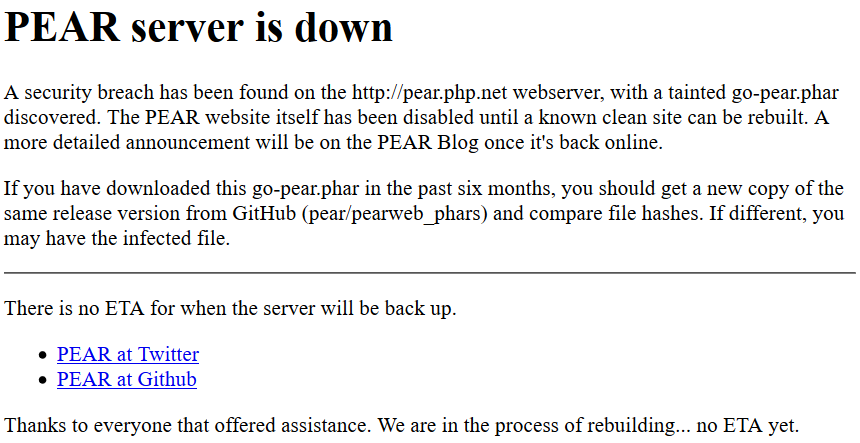This is a serious hijack of a toolchain used by developers.

Pear.php.net shuts down after maintainers discover serious supply-chain attack.
Source: If you installed PEAR PHP in the last 6 months, you may be infected | Ars Technica
This is a serious hijack of a toolchain used by developers.

Pear.php.net shuts down after maintainers discover serious supply-chain attack.
Source: If you installed PEAR PHP in the last 6 months, you may be infected | Ars Technica
Marvell Wifi System-on-chip, which is used by Valve Steamlink, PS 4, Microsoft Surface and Samsung Chromebook is susceptible to remote compromise. Here’s the kicker: the device can be compromised just by the fact that it’s powered on. There is no need for the victim to visit any website or click on any links. That’s what makes this RCE (remote code execution) so dangerous and potent.
This vulnerability can be triggered without user interaction during the scanning for available networks. This procedure is launched every 5 minutes regardless of a device being connected to some Wi-Fi network or not. That’s why this bug is so cool and provides an opportunity to exploit devices literally with zero-click interaction at any state of wireless connection (even when a device isn’t connected to any network).
This is a case that will test the limits of exclusion in the brave new world of cybersecurity insurance. Basically, the insurance company is refusing to pay for cybersecurity related damages by citing an exclusion clause which states the malware was created as part of a cyber warfare.
What if courts and lawyers actually start believing the cyberwar narrative and acting as if any damage caused to Western companies is uninsurable war damage?
…
What will happen to the insurance of cyber risks if any attack could potentially be declared part of a war?
Source: Mondelez Lawsuit Shows the Dangers of Attributing Cyberattacks – Bloomberg
The state of Cat 6 cables sold in the market is appallingly bad.
Plainly enough, most of these cables aren’t designed to meet Cat 6 or 6a specifications, and they’re certainly not tested for compliance before leaving the plant.
CAPTCHA is almost ubiquitous in today’s web applications and an extremely popular CAPTCHA implementation is Google’s, namely reCaptcha. reCaptcha provides an audio version for visually-impaired users. Researchers manage to make use of free speech-to-text services to defeat audio reCaptcha.
unCaptcha: Talk is cheap in defeating reCaptcha
Source: unCaptcha: A Low-Resource Defeat of reCaptcha’s Audio Challenge
“Why stop at 4?”
Nokia’s next flagship Android phone features five cameras, a 5.99-inch PureDisplay, more.
Source: Nokia’s Next Android Flagship Features Five Cameras – Thurrott.com
In a move that has sent shock waves through the cybersecurity and software community, Australia passes new law that could potentially devastate its software industry, by compelling tech companies to help law enforcement break into user’s encrypted data.
Both countries now claim the right to secretly compel tech companies and individual technologists, including network administrators, sysadmins, and open source developers – to re-engineer software and hardware under their control, so that it can be used to spy on their users. Engineers can be penalized for refusing to comply with fines and prison; in Australia, even counseling a technologist to oppose these orders is a crime.
Source: In the New Fight for Online Privacy and Security, Australia Falls:
A novel way of scamming. Make your phone number appear in Google Maps by claiming it. People who clicks on the result of Google Maps gets directed to you. Profit!
When you see any information listed on a website, your first reaction isn’t to immediately question whether or not that information is accurate. It is to blindly trust the technology that has helped you unfailingly countless times in the past. That is precisely why this scam is so potent.
Source: New form of Google banking scam
Great story based on a true hacking attempt.
Except for the last bit which was dramatized, the author gave a fairly good first-person account of an internal pentesting being carried out. It involves everything from impersonation, social engineering, physical theft, wits and a good amount of luck.
“Good afternoon, Pam. I’m Josh from IT. We’re about to migrate your Citrix instance to a new server. I’m going to send you a 6 digit number. I’ll need you to read that off to me. As a reminder, IT will never ask for your password.”
I already had her password.
She gave a hesitant, “Okay…”
I clicked on the “Click for MFA token” button and stated, “Alright, I’ve sent you the number. You should get a text. Please read it to me.”
She said, “Umm, alright. Got it. It’s 9-0-5-2-1-2.”
Source: A thread written by @TinkerSec
Woops. YouTube is down at the moment.
It’s interesting that Google chooses to display an encrypted message (presumably containing details of the error) on the client browser. This is certainly a novel way for users to report the problem without exposing potentially sensitive details (eg. file paths) to them.
YouTube is down and reports are coming in worldwide about the service being unavailable.
Source: YouTube Down According to Reports Worldwide & Twitter Reacts
Update: Service is up after about 2 hours